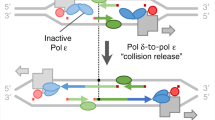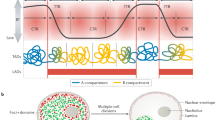Abstract
EUKARYOTTC DNA can be isolated as long fibres on which replication has occurred at several locations1–9. These replicating units are arranged in tandem and spaced at intervals which vary in length from 1–> 100 µm2–5,7–9. Although it can be determined that at any time replication has been initiated from a particular position on a fibre, it is not known whether that position remains fixed from one round of replication to the next, nor whether replication terminates at fixed locations on the DNA fibre. Attempts to resolve these questions have used experiments in which replicated units are visualised and their length and spatial distribution reconciled with models of fixed4,5 or varying3,8 sites of initiation and termination. Different studies have reached the different conclusions that these sites are variable3,8 or fixed4,5 (particularly with respect to termination of replication). All of these studies have been complicated by the observation that the length of replicated regions seems to vary in a manner consistent with a broad but continuous distribution for the length of the replicating unit. Such a distribution could reflect variation in the position of fixed termination sites or the fact that termination is not at a fixed position on the DNA fibre.
This is a preview of subscription content, access via your institution
Access options
Subscribe to this journal
Receive 51 print issues and online access
$199.00 per year
only $3.90 per issue
Buy this article
- Purchase on Springer Link
- Instant access to full article PDF
Prices may be subject to local taxes which are calculated during checkout
Similar content being viewed by others
References
Cairns, J., J. molec. Biol., 15, 372–373 (1966).
Huberman, J. A., and Riggs, A. D., J. molec. Biol., 32, 327–341 (1968).
Callan, H. G., Proc. R. Soc., B 181, 19–41 (1972).
Hori, T., and Lark, K. G., J. molec. Biol., 77, 391–404 (1973).
Hori, T., and Lark, K. G., J. molec. Biol., 88, 221–232 (1974).
Hand, R., and Tamm, I., Virology, 47, 331–337 (1972).
Hand, R., and Tamm, I., J. molec Biol., 82, 175–183
Blumenthal, A. B., Krigstein, H. J., and Hogness, D.S., Cold Spring Harb. Symp. quant. Biol., 38, 205–223 (1973).
Wolstenholme, D. R., Chromosoma, 43, 1–18 (1973).
Hatch, F. T., and Mazrimas, J. A., Biochem. biophys. Acta, 224, 291–294 (1970).
Bostock, C., Prescott, D. M., and Hatch, F. T., Expl Cell Res., 74, 487–495 (1972).
Author information
Authors and Affiliations
Rights and permissions
About this article
Cite this article
HORI, T., LARK, K. Evidence for defined lengths of DNA replication units in ‘satellite’ DNA from D. ordii. Nature 259, 504–505 (1976). https://doi.org/10.1038/259504a0
Received:
Accepted:
Issue Date:
DOI: https://doi.org/10.1038/259504a0
This article is cited by
-
The Red function of phage λ mediates the alteration of an interspersed repeated DNA sequence from the kangaroo rat dipodomys ordii
Molecular and General Genetics MGG (1982)
-
Chromosomal replication in Drosophila virilis
Chromosoma (1981)
-
Human DNA replication: Fiber autoradiographic analysis of diploid cells from normal adults and from Fanconi's anemia and ataxia telangiectasia
Human Genetics (1977)
-
Evidence for a four micron replication unit in CHO cells
Chromosoma (1976)
Comments
By submitting a comment you agree to abide by our Terms and Community Guidelines. If you find something abusive or that does not comply with our terms or guidelines please flag it as inappropriate.



